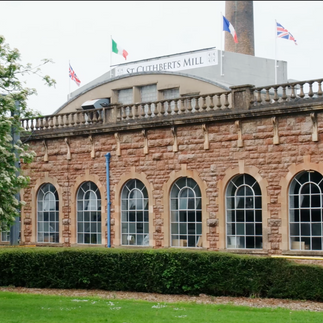Inside the Mill: A Rare Look Behind the Scenes at St Cuthberts
- harwoodkingsales
- Sep 3
- 4 min read
At the heart of Somerset, tucked away on the edge of Wells, lies a mill where centuries of craftsmanship, nature, and precision converge to produce some of the finest papers in the world. On a recent visit, we were fortunate to step inside St Cuthbert's Mill — the birthplace of the renowned Somerset and Waterford papers we so often use for our giclée prints and flatbed printing projects.
This wasn’t just a factory tour. It was a rare chance to see one of the last cylinder mould machines in the world still in operation — and a deep dive into the artistry, history, and science of papermaking.
A Location Chosen by Nature
St Cuthberts Mill has been making paper on this site since the 1700s. Its location wasn’t a coincidence — it sits beside the River Axe, close to its source at Wookey Hole Caves, where water naturally filtered through the Mendip limestone emerges clean and mineral-rich. This crystal-clear water is central to the papermaking process and is recycled multiple times before being returned to the river — as clean (if not cleaner) than when it came in. The river downstream from the mill boasts the highest classification for cleanliness and biodiversity.
But even with today’s modern controls, the clarity and conditions of the incoming water can still subtly influence the paper from day to day — a reminder that no matter how refined the process, nature still plays a role.
From Cotton to Sheet: The Anatomy of a Printmaking Paper
The primary ingredient in Somerset and Waterford papers is cotton linters — the long, silky fibres left attached to cotton seeds, which are a by-product of the textile industry. These linters are high in alpha cellulose, giving the paper its archival qualities, strength, and luxurious texture.
The process begins with pulping: the cotton linters are mixed with water in a machine called a Lamort (from the French la mort, or “the death” — an ominous but fitting name for a piece of kit that could grind a person as easily as it does cotton). Here, the fibres are broken down into a thick, creamy pulp.
Many of the terms in British papermaking come from French, a legacy of how the craft moved from China to Spain, through France, and finally to the UK. That history still echoes through the mill.
The Mould Machine: Where the Magic Happens
Once the pulp is ready, it’s fed into the tanks that supply the cylinder mould machine — a beautiful piece of engineering originally built in 1907. Unlike standard paper machines that align fibres in one direction, mould machines allow fibres to lie in all directions, giving the finished paper its strength and resilience. That’s what makes it ideal for wet media like watercolour, etching, or ink-heavy giclée prints.
As the pulp hits the rotating cylinder, which is covered in a fine mesh, the water is drawn away, and a delicate web of paper begins to form. This is also where the watermark — either Somerset or Waterford — is embedded, pressed into the paper by raised patterns on the mesh.
Texture, Felt, and the Art of Surface
Once the pulp forms a sheet, it’s passed through a series of natural wool felts, which help define the surface texture of the paper. These felts also create the distinction between the ‘felt’ side and the ‘mould’ side — terms familiar to many artists.
The felt side is the top layer, which first touches the wool and tends to have a more organic, random surface.
The mould side lies against the cylinder mesh, and has a slightly more regular pattern due to the grid imprint.
Many artists prefer the felt side for its more natural texture — though both are beautiful and usable depending on the medium.
Over time, the felts wear, subtly altering the texture they imprint. Paper produced at the beginning of a felt’s life will differ ever so slightly from that made toward the end. Even this fine detail is part of the craft.
A Process of Precision and Patience
Before a full production run begins, the team creates a test roll, subjecting it to 50–70 quality checks. Everything from colour consistency to fibre dispersion, weight, density and even microscopic imperfections are assessed and adjusted in real-time.
And throughout production, scanners monitor the sheet for flaws — but humans remain a vital part of the process. One memorable story involved a perfectly preserved butterfly that had somehow flown into the paper at the moulding stage. It wasn’t spotted until the paper was hand-torn in the final finishing salle — a testament to both the sensitivity of the team and the uniqueness of every sheet.
From the Mill to the Studio
Once complete, the paper is either cut or hand-torn into sheets or coated for giclée printing and rolled for shipment. This is the paper we love working with — and the care, tradition, and expertise behind it give each print a depth and integrity that simply can’t be faked.
It’s a reminder that great prints don’t just start with an image — they start with great materials.
If you’d like to see how we use these materials, explore our giclée printing services or flatbed printing options.
Let’s Talk Paper
We left St Cuthberts inspired by the passion of their master papermakers and reminded of just how much work happens before ink ever hits the page.
If you’re planning a print edition, an exhibition, or looking to explore new materials for your work — we’d love to talk. Learn more about our giclée printing or flatbed printing and let’s make something beautiful together.
























